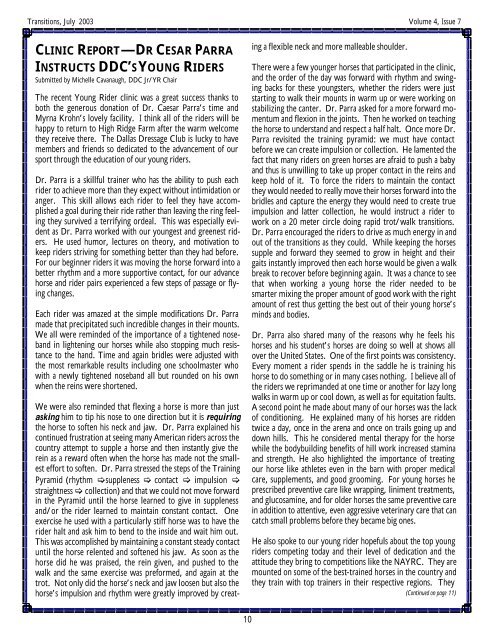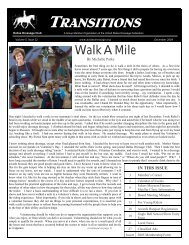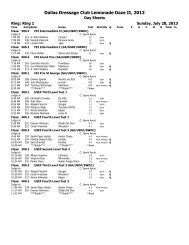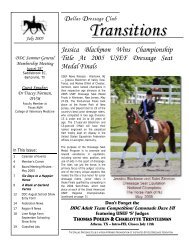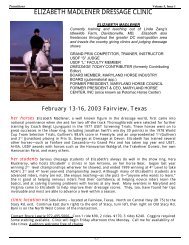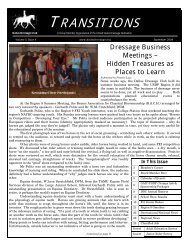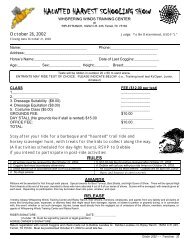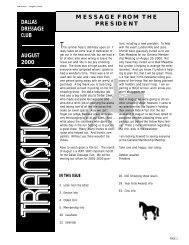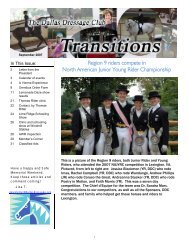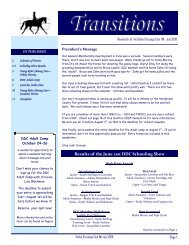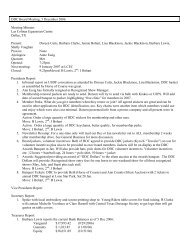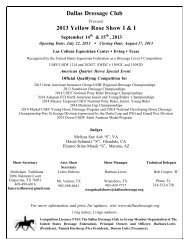2003 July - Dallas Dressage Club
2003 July - Dallas Dressage Club
2003 July - Dallas Dressage Club
Create successful ePaper yourself
Turn your PDF publications into a flip-book with our unique Google optimized e-Paper software.
Transitions, <strong>July</strong> <strong>2003</strong> Volume 4, Issue 7<br />
CLINIC REPORT—DR CESAR PARRA<br />
INSTRUCTS DDC’S YOUNG RIDERS<br />
Submitted by Michelle Cavanaugh, DDC Jr/YR Chair<br />
The recent Young Rider clinic was a great success thanks to<br />
both the generous donation of Dr. Caesar Parra’s time and<br />
Myrna Krohn’s lovely facility. I think all of the riders will be<br />
happy to return to High Ridge Farm after the warm welcome<br />
they receive there. The <strong>Dallas</strong> <strong>Dressage</strong> <strong>Club</strong> is lucky to have<br />
members and friends so dedicated to the advancement of our<br />
sport through the education of our young riders.<br />
Dr. Parra is a skillful trainer who has the ability to push each<br />
rider to achieve more than they expect without intimidation or<br />
anger. This skill allows each rider to feel they have accomplished<br />
a goal during their ride rather than leaving the ring feeling<br />
they survived a terrifying ordeal. This was especially evident<br />
as Dr. Parra worked with our youngest and greenest riders.<br />
He used humor, lectures on theory, and motivation to<br />
keep riders striving for something better than they had before.<br />
For our beginner riders it was moving the horse forward into a<br />
better rhythm and a more supportive contact, for our advance<br />
horse and rider pairs experienced a few steps of passage or flying<br />
changes.<br />
Each rider was amazed at the simple modifications Dr. Parra<br />
made that precipitated such incredible changes in their mounts.<br />
We all were reminded of the importance of a tightened noseband<br />
in lightening our horses while also stopping much resistance<br />
to the hand. Time and again bridles were adjusted with<br />
the most remarkable results including one schoolmaster who<br />
with a newly tightened noseband all but rounded on his own<br />
when the reins were shortened.<br />
We were also reminded that flexing a horse is more than just<br />
asking him to tip his nose to one direction but it is requiring<br />
the horse to soften his neck and jaw. Dr. Parra explained his<br />
continued frustration at seeing many American riders across the<br />
country attempt to supple a horse and then instantly give the<br />
rein as a reward often when the horse has made not the smallest<br />
effort to soften. Dr. Parra stressed the steps of the Training<br />
Pyramid (rhythm [suppleness [ contact [ impulsion [<br />
straightness [ collection) and that we could not move forward<br />
in the Pyramid until the horse learned to give in suppleness<br />
and/or the rider learned to maintain constant contact. One<br />
exercise he used with a particularly stiff horse was to have the<br />
rider halt and ask him to bend to the inside and wait him out.<br />
This was accomplished by maintaining a constant steady contact<br />
until the horse relented and softened his jaw. As soon as the<br />
horse did he was praised, the rein given, and pushed to the<br />
walk and the same exercise was preformed, and again at the<br />
trot. Not only did the horse’s neck and jaw loosen but also the<br />
horse’s impulsion and rhythm were greatly improved by creating<br />
a flexible neck and more malleable shoulder.<br />
There were a few younger horses that participated in the clinic,<br />
and the order of the day was forward with rhythm and swinging<br />
backs for these youngsters, whether the riders were just<br />
starting to walk their mounts in warm up or were working on<br />
stabilizing the canter. Dr. Parra asked for a more forward momentum<br />
and flexion in the joints. Then he worked on teaching<br />
the horse to understand and respect a half halt. Once more Dr.<br />
Parra revisited the training pyramid: we must have contact<br />
before we can create impulsion or collection. He lamented the<br />
fact that many riders on green horses are afraid to push a baby<br />
and thus is unwilling to take up proper contact in the reins and<br />
keep hold of it. To force the riders to maintain the contact<br />
they would needed to really move their horses forward into the<br />
bridles and capture the energy they would need to create true<br />
impulsion and latter collection, he would instruct a rider to<br />
work on a 20 meter circle doing rapid trot/walk transitions.<br />
Dr. Parra encouraged the riders to drive as much energy in and<br />
out of the transitions as they could. While keeping the horses<br />
supple and forward they seemed to grow in height and their<br />
gaits instantly improved then each horse would be given a walk<br />
break to recover before beginning again. It was a chance to see<br />
that when working a young horse the rider needed to be<br />
smarter mixing the proper amount of good work with the right<br />
amount of rest thus getting the best out of their young horse’s<br />
minds and bodies.<br />
Dr. Parra also shared many of the reasons why he feels his<br />
horses and his student’s horses are doing so well at shows all<br />
over the United States. One of the first points was consistency.<br />
Every moment a rider spends in the saddle he is training his<br />
horse to do something or in many cases nothing. I believe all of<br />
the riders we reprimanded at one time or another for lazy long<br />
walks in warm up or cool down, as well as for equitation faults.<br />
A second point he made about many of our horses was the lack<br />
of conditioning. He explained many of his horses are ridden<br />
twice a day, once in the arena and once on trails going up and<br />
down hills. This he considered mental therapy for the horse<br />
while the bodybuilding benefits of hill work increased stamina<br />
and strength. He also highlighted the importance of treating<br />
our horse like athletes even in the barn with proper medical<br />
care, supplements, and good grooming. For young horses he<br />
prescribed preventive care like wrapping, liniment treatments,<br />
and glucosamine, and for older horses the same preventive care<br />
in addition to attentive, even aggressive veterinary care that can<br />
catch small problems before they became big ones.<br />
He also spoke to our young rider hopefuls about the top young<br />
riders competing today and their level of dedication and the<br />
attitude they bring to competitions like the NAYRC. They are<br />
mounted on some of the best-trained horses in the country and<br />
they train with top trainers in their respective regions. They<br />
(Continued on page 11)<br />
10


